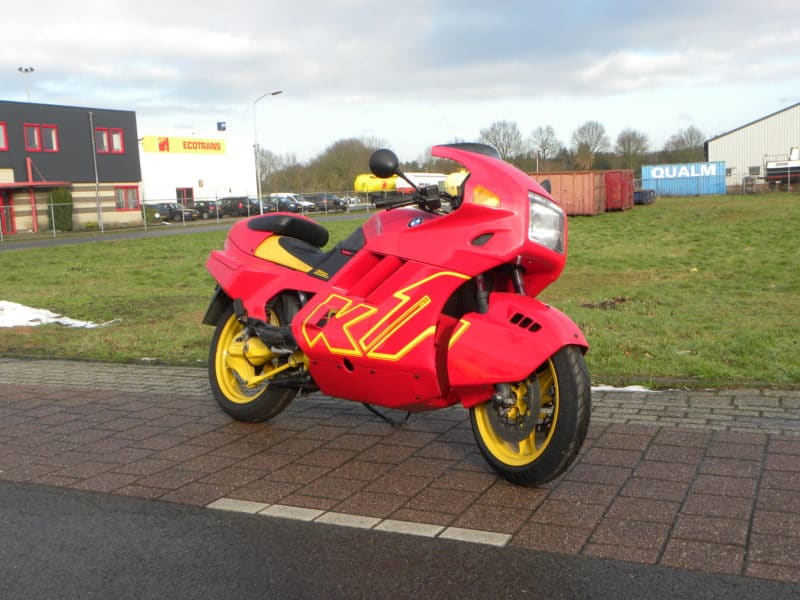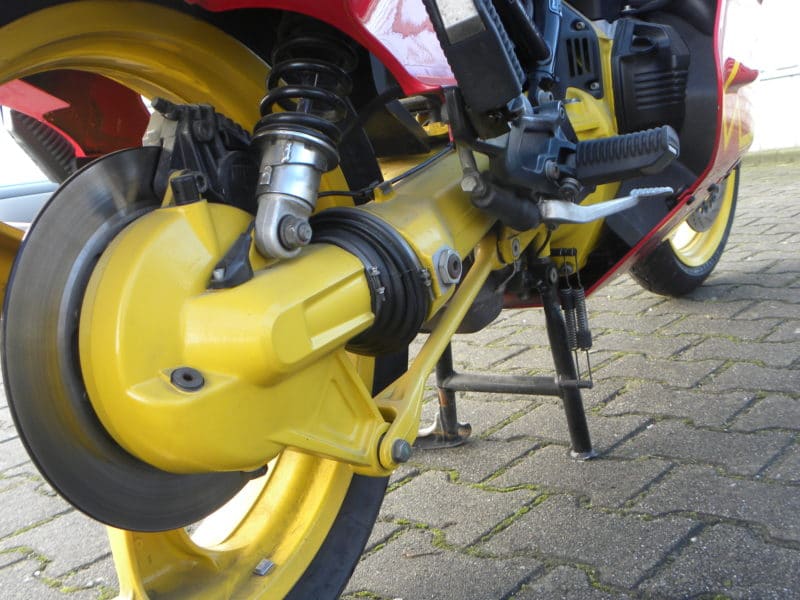BMW made 'old cock engines'. That was clearly the perception of the more dynamic motorcyclists after the arrival of the large, fast Japanese four-cylinder. But sturdy blond techies with square foreheads above their blue eyes can of course also go crazy. Also at BMW. If you just give them the chance. So the BMW K1.
The boxers would be 'phased out'
The K-series, which according to the BMW management had to follow the old-fashioned boxertwins, had already caused the stomach acid to rise to the lips of many old school BMW drivers. As good as the K100 and K75 were: They weren't Boxers! It was reprehensible novelty! And then came the BMW K1. And that left people speechless. They didn't speak up about it. And until a few years ago the mood in the market was such that a K1 could not fetch more than € 3.000. And then there had to be little, very little to criticize.
Ivanhoe's rocking horse
The uniquely styled BMW K1 (1988/1993), that was surely the most astonishing BMW ever made. The K1 had some construction features that could be traced back to the 'Futuro' concept car from 1981. That too was a fully streamlined machine with a basic paralever shape, but without a front fender at all. And that front mudguard was not to be missed on the K1. Like the Futuro, the K1 had integrated 'cases', but these were actually like the K1 glove boxes with a superiority complex.
The first set-up of the BMW was done in subdued black and those involved spoke fondly of 'the Black Widow'. They no longer spoke about 'fairing parts', but about 'the bodywork'. The Festively Wrapped BMW changed the idea of what kind of motorcycles BMW could make globally. What motorcycles could look like. He was revolutionary, with the necessary caveats that come with going, very bravely, untrodden paths.
Purists hated the "case-suppository" shapes and entire tribes were confused by the body graphics and color-painted wheels. Tastes are debatable, but the K1 was a masterful piece of equipment. The four-cylinder was made to blow on 'Autobahn' for a long time with a cruising speed above 200 km/h. The seven-part plating provided an air/drag coefficient of 0,38. The rider had to lie flat on the tank for this. Otherwise, the story collapsed.
Streamline as an emergency jump
That super streamline was a kind of emergency jump to get up to speed because of the power limitation to 100 hp imposed by German importers and dealers themselves. The K100 delivered 90. The K1 was equipped with a 16-valve cylinder head and delivered 100. Compared to the K100, the compression was increased and the crankshaft was made 1,3 kilograms lighter. The measurement and control work was done by a digital engine management. The K1 had a stiffer frame than the K100 and stood on - for the time - wide low profile tires. The result of all that effort was a bit disappointing. The motor was mounted directly in the frame and that caused some vibrations. All the plating and the wide tires made the K1 on the heavy side, even though BMW had kept the plating as light (as thin) as possible. And with its hundred horses, the K1 was no match for the Japanese machines of about 1000 cc in terms of acceleration. But the two-wheeler, equipped with its unique body, was a wonderful, fast travel machine. A vehicle for which the Italians would have used the slogan 'GT' (gran turisimo).
And the time when you had a nice K1 for 3.000 euros? That time is over.
Also read:
– About the benefits of a Auto Motor Klassiek Subscription
- BMW K1, can it be crazier?
- BMW K100
- More stories about classic engines
- BMW R100/7. From the Eleven Cities Tour time

DSCN0935 DSCN0908





I have had a blue / yellow K15 for 1 years now. Am very proud of it. For me great classic that is like no other. You stand out in the crowd. No wretch at the traffic lights. Thumbs up. Yes bold design. But matures quite nicely. If you look at the first brochures, the production model has a few extra holes in the fairing. First, the legs got very hot. Secondly, the extreme fairing created a negative pressure behind the fairing that took the rider's breath away from 170 km/h. Funny detail.
Very nice machine, especially after it was performed in Germany at the famous garage.
The first 4-valve series production BMW engine which continued the Aero era. Honda already had an Aero series in the form of a CBR-400 (Japan) which later paved the way for the first CBR600/750(us) and 1000 bathtubs. It was recognized that Aerodynamics made up for what was lacking in power. Hans A Muth, famous for the Gen1 Katanas, but also the Futuro-R100 turbo boxer, was never involved in the K1. He was allowed to draw the R45/65LS, after which BMW Design und Forschung took over the entire design line from '84-
Kawasaki then (1988) also completely streamlined the ZX-10 Tomcat on the road, 1000 cm3 and 130 + hp.
The fastest production model at the time, 265+ km/h
BMW remains a much too expensive engine, even in maintenance. They cannot match the Japanese. It also remains a suitcase motorcycle with make-up in it
All things considered, it is actually the front fender that deviates from the norm; If you think it away or replace it with a less elaborate one, the bike will turn into a possibly older VFR or similar.
I think it's a bold design.
Wasn't this also the first production bike with ABS….?
I do have a weakness for designs that stir people's minds, even if I rarely find them beautiful. And if the prices attract the prices of motorcycles that were once barely giving away (MZ 250 Trophy, Suzuki RE5, etc.) I think that's fine for the - often first - owners. I also wish that fate to those who once put their sights and money on the K-1.
But besides being ugly, I think this bike has a kind of 'Duplo' look; even if the thing runs three hundred, I can't find it 'tough'. Could it be that hamburger clown's bike?
K1, you love it or you heart it. A friend of mine absolutely adores it. He has had a red/yellow one from 1993 for many years. Once bought from a Toyota dealer, who had exchanged it for a car.
He also had an R100RT for commuting to work. Sold the latter at some point and purchased an R100 with sidecar. This one left a few years ago and a K1 has taken its place, with sidecar. These are only for the scenic rides.
For normal work (he is now retired) a K1100RT has been added. Next to a car that also roams somewhere.
Recently I was with him, when he was also fiddling with 2 K75's, in Polizei version.
He had tripped over that, for not too much 😀.
When he was done with that, they were allowed to go back to an enthusiast.
Here and there I have seen a K1 in the wild, but those were only a few. The look was new and actually magical. A CW value of 0,39 was something from heaven, compared to regular touring bikes. Have you ever seen one at Jan Beck's. Then finally one could take a closer look, I played with the devised…..what if i….. But the seat seemed kind of unsuitable for someone whose back can no longer go into sports position. Anyway, I still think it's an iconic bike. BMW made the K1 'out of the blue' and others would follow suit in their own way. Just like with the Golf GTI. Soon it was definitely not the fastest anymore, but it remained the most iconic.